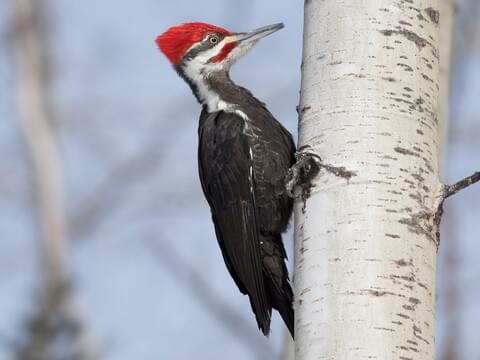Coming Across Woodpeckers in Florida Species: Environments and Behavior
Coming Across Woodpeckers in Florida Species: Environments and Behavior
Blog Article
Discover the Remarkable Globe of Woodpeckers: Everything You Required to Know
The globe of woodpeckers is a world full of unique behaviors, intricate adaptations, and a varied array of types. From their habitats and distribution patterns to their feeding behaviors and specialized physiological features, woodpeckers have actually long mesmerized the passion of ornithologists and nature enthusiasts alike. Comprehending the intricacies of these remarkable birds supplies a peek right into the complex interplay in between their biology and the setting. As we explore the globe of woodpeckers additionally, we reveal a wealth of info that clarifies their value in environments and the obstacles they encounter in an ever-changing globe.
Woodpecker Habitats and Circulation
Woodpeckers live in a varied series of settings worldwide, showcasing versatility in their circulation patterns. These durable birds are located in forests, timberlands, savannas, and deserts throughout various continents, demonstrating their ability to thrive in various weather problems. In North America, for example, woodpeckers can be spotted in both coniferous and deciduous woodlands, utilizing their solid beaks to forage for pests and develop nesting cavities in trees. In Africa, specific woodpecker varieties have actually adapted to dry settings, such as the acacia woodlands, where they play a vital function in regulating insect populations.

Feeding Behaviors and Diet Plan
Woodpeckers use their solid beaks to pierce into the bark of trees, probing for insects and larvae hidden under the surface area. In enhancement to insects, woodpeckers additionally take in nuts, seeds, fruits, and sap.
Woodpeckers are known for their drumming behavior, which offers not just to interact with other woodpeckers yet also to situate food. The fast drumming noise is created by the bird pecking on resonant surface areas like dead trees or metal posts. This behavior can draw in insects hidden in the timber, enabling the woodpecker to discover their presence and eat them.
Distinct Adjustments for Tree Climbing
In their adept pursuit of bugs hidden within tree bark, woodpeckers have actually evolved exceptional anatomical features that equip them with special adaptations for effective tree climbing. Among the essential adaptations is their zygodactyl feet, with two toes pointing forward and 2 pointing backwards, giving a solid grip on tree trunks. This customized foot setup enables woodpeckers to hold on to vertical surfaces easily, enabling them to go up and down trees with agility. In addition, woodpeckers have tight tail plumes that serve as an encouraging prop while they climb up, helping in equilibrium and security. Their strong, chisel-like beaks are not only made use of for exploration right into wood however likewise for gripping onto bark as they rise tree trunks. Woodpeckers have strong neck muscle mass and an our website unique skull structure that soak up the influence of consistent pecking, enabling them to climb up up and down without creating injury to their minds. These adjustments display the amazing evolutionary layout that makes it possible for woodpeckers to browse trees with precision and performance.
Diverse Woodpecker Types Worldwide
With over 200 different species spread across different environments worldwide, the family members of Picidae includes an exceptional variety of woodpeckers. These birds can be located in woodlands, timberlands, savannas, and also city areas, showcasing their flexibility to various environments. From the renowned Northern Flicker in North America to the colorful and elusive Crimson-backed Flameback in Asia, each woodpecker species displays one-of-a-kind attributes in regards to quill, actions, and environment preference.
Woodpeckers differ greatly in size, with the diminutive Downy Woodpecker determining around 6-7 inches in size, while the powerful Lineated Woodpecker can rise to 17 inches - Woodpeckers in Florida. Their beaks likewise are available in different sizes and shapes, mirroring their feeding behaviors. Some species specialize in drawing out pests from tree bark, like the Acorn Woodpecker, while others, such as the Black-cheeked Woodpecker, prey on fruits and seeds

Preservation Efforts and Difficulties
Conservation initiatives for woodpecker populaces are vital in mitigating the impact of environment loss and other risks dealing with these varied bird species. Woodpeckers face various obstacles to their survival, largely due to deforestation, urbanization, environment adjustment, and intrusive varieties. To deal with these concerns, preservation efforts concentrate on shielding and restoring woodpecker environments, carrying out lasting forestry methods, and elevating recognition concerning the value of these birds in ecosystems.
One substantial challenge in woodpecker preservation is the fragmentation of their environments, bring about separated populaces that are much more prone to termination - Woodpeckers in Florida. Guardians work to develop wildlife hallways and safeguarded areas that attach these fragmented habitats, permitting woodpeckers to move in between different areas for feeding, breeding, and shelter

Final Thought
To conclude, woodpeckers are remarkable birds with unique adaptations for tree climbing and feeding actions. They can be found in varied environments worldwide, encountering conservation challenges due to environment loss and human tasks. Comprehending their habitats, diet regimens, and behaviors is vital for preservation efforts to safeguard these crucial bird varieties. More study and conservation activities are required to ensure the survival of woodpeckers more in the link wild.
Report this page